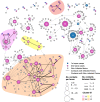Integration of genetic and epidemiological data to infer H5N8 HPAI virus transmission dynamics during the 2016-2017 epidemic in Italy
- PMID: 30575785
- PMCID: PMC6303474
- DOI: 10.1038/s41598-018-36892-1
Integration of genetic and epidemiological data to infer H5N8 HPAI virus transmission dynamics during the 2016-2017 epidemic in Italy
Abstract
Between October 2016 and December 2017, several European Countries had been involved in a massive Highly Pathogenic Avian Influenza (HPAI) epidemic sustained by H5N8 subtype virus. Starting on December 2016, also Italy was affected by H5N8 HPAI virus, with cases occurring in two epidemic waves: the first between December 2016 and May 2017, and the second in July-December 2017. Eighty-three outbreaks were recorded in poultry, 67 of which (80.72%) occurring in the second wave. A total of 14 cases were reported in wild birds. Epidemiological information and genetic analyses were conjointly used to get insight on the spread dynamics. Analyses indicated multiple introductions from wild birds to the poultry sector in the first epidemic wave, and noteworthy lateral spread from October 2017 in a limited geographical area with high poultry densities. Turkeys, layers and backyards were the mainly affected types of poultry production. Two genetic sub-groups were detected in the second wave in non-overlapping geographical areas, leading to speculate on the involvement of different wild bird populations. The integration of epidemiological data and genetic analyses allowed to unravel the transmission dynamics of H5N8 virus in Italy, and could be exploited to timely support in implementing tailored control measures.
Conflict of interest statement
The authors declare no competing interests.
Figures






Similar articles
-
Multiple introductions of reassorted highly pathogenic avian influenza viruses (H5N8) clade 2.3.4.4b causing outbreaks in wild birds and poultry in Egypt.Infect Genet Evol. 2018 Mar;58:56-65. doi: 10.1016/j.meegid.2017.12.011. Epub 2017 Dec 14. Infect Genet Evol. 2018. PMID: 29248796
-
Genetic Characterization of Highly Pathogenic Avian Influenza A(H5N8) Virus in Pakistani Live Bird Markets Reveals Rapid Diversification of Clade 2.3.4.4b Viruses.Viruses. 2021 Aug 18;13(8):1633. doi: 10.3390/v13081633. Viruses. 2021. PMID: 34452498 Free PMC article.
-
Genetic relationship between poultry and wild bird viruses during the highly pathogenic avian influenza H5N6 epidemic in the Netherlands, 2017-2018.Transbound Emerg Dis. 2019 May;66(3):1370-1378. doi: 10.1111/tbed.13169. Epub 2019 Apr 5. Transbound Emerg Dis. 2019. PMID: 30874364 Free PMC article.
-
The genetics of highly pathogenic avian influenza viruses of subtype H5 in Germany, 2006-2020.Transbound Emerg Dis. 2021 May;68(3):1136-1150. doi: 10.1111/tbed.13843. Epub 2020 Sep 29. Transbound Emerg Dis. 2021. PMID: 32964686 Review.
-
Peering into Avian Influenza A(H5N8) for a Framework towards Pandemic Preparedness.Viruses. 2021 Nov 15;13(11):2276. doi: 10.3390/v13112276. Viruses. 2021. PMID: 34835082 Free PMC article. Review.
Cited by
-
Association of wild bird densities around poultry farms with the risk of highly pathogenic avian influenza virus subtype H5N8 outbreaks in the Netherlands, 2016.Transbound Emerg Dis. 2021 Jan;68(1):76-87. doi: 10.1111/tbed.13595. Epub 2020 May 18. Transbound Emerg Dis. 2021. PMID: 32419342 Free PMC article.
-
Elucidating the Local Transmission Dynamics of Highly Pathogenic Avian Influenza H5N6 in the Republic of Korea by Integrating Phylogenetic Information.Pathogens. 2021 Jun 2;10(6):691. doi: 10.3390/pathogens10060691. Pathogens. 2021. PMID: 34199439 Free PMC article.
-
Risk Factors Contributing to Highly Pathogenic Avian Influenza H5N6 in China, 2014-2021: Based on a MaxEnt Model.Transbound Emerg Dis. 2023 Sep 15;2023:6449392. doi: 10.1155/2023/6449392. eCollection 2023. Transbound Emerg Dis. 2023. PMID: 40303723 Free PMC article.
-
Predictiveness and drivers of highly pathogenic avian influenza outbreaks in Europe.Sci Rep. 2025 Jul 17;15(1):20286. doi: 10.1038/s41598-025-04624-x. Sci Rep. 2025. PMID: 40675996 Free PMC article.
-
Spatiotemporal reconstruction and transmission dynamics during the 2016-17 H5N8 highly pathogenic avian influenza epidemic in Italy.Transbound Emerg Dis. 2021 Jan;68(1):37-50. doi: 10.1111/tbed.13420. Epub 2019 Dec 1. Transbound Emerg Dis. 2021. PMID: 31788978 Free PMC article.
References
-
- European Food Safety Authority. Highly pathogenic avian influenza A subtype H5N8. EFSA J. 12, 3941 (2014).
Publication types
MeSH terms
Grants and funding
LinkOut - more resources
Full Text Sources
Medical

